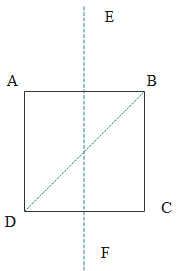
For given uniform square lamina ABCD, whose centre is O, which of the following is correct?

(A) $\sqrt {{{21}_{AC}}} = {1_{EF}}$
(B) ${I_{AD}} = {31_{EF}}$
(C) ${I_{AD}} = {I_{EF}}$
(D) ${I_{AC}} = \sqrt {{{21}_{EF}}}$
Answer
218.4k+ views
Hint The moment of inertia is defined to be a quantity which expresses a body’s tendency to the resist angular acceleration, which is known as the sum of the products of the mass of each of the particle in the body with the square of the distance from the axis of rotation. Based on this concept we can solve this question.
Complete step by step answer:
We know that the moment of inertia of a square lamina about an axis perpendicular to its plane = $\dfrac{{m{l^2}}}{6}$
Therefore, by perpendicular axes theorem,
${21_{EF}} = \dfrac{{m{l^2}}}{6} \to {I_{EF}} = \dfrac{{m{l^2}}}{{12}}$
Similarly,
${21_{AC}} = \dfrac{{m{l^2}}}{6} \to {I_{AC}} = \dfrac{{m{l^2}}}{{12}}$
${I_{AC}} = {I_{EF}}$
Hence, the correct answer is Option A.
Note The concept of moment of inertia is important because all the physics problems that involve all the masses in the rotational motion. It will be used to calculate the angular momentum and allows us to explain. This explanation is done using the conservation of the angular momentum. If we increase the radius of the axis of rotation, the moment of inertia increases. This will result in the lowering of the speed of rotation.
Complete step by step answer:
We know that the moment of inertia of a square lamina about an axis perpendicular to its plane = $\dfrac{{m{l^2}}}{6}$
Therefore, by perpendicular axes theorem,
${21_{EF}} = \dfrac{{m{l^2}}}{6} \to {I_{EF}} = \dfrac{{m{l^2}}}{{12}}$
Similarly,
${21_{AC}} = \dfrac{{m{l^2}}}{6} \to {I_{AC}} = \dfrac{{m{l^2}}}{{12}}$
${I_{AC}} = {I_{EF}}$
Hence, the correct answer is Option A.
Note The concept of moment of inertia is important because all the physics problems that involve all the masses in the rotational motion. It will be used to calculate the angular momentum and allows us to explain. This explanation is done using the conservation of the angular momentum. If we increase the radius of the axis of rotation, the moment of inertia increases. This will result in the lowering of the speed of rotation.
Recently Updated Pages
Chemical Properties of Hydrogen - Important Concepts for JEE Exam Preparation

JEE General Topics in Chemistry Important Concepts and Tips

JEE Atomic Structure and Chemical Bonding important Concepts and Tips

JEE Amino Acids and Peptides Important Concepts and Tips for Exam Preparation

JEE Extractive Metallurgy Important Concepts and Tips for Exam Preparation

Algebra Made Easy: Step-by-Step Guide for Students

Trending doubts
JEE Main 2026: Application Form Open, Exam Dates, Syllabus, Eligibility & Question Papers

Derivation of Equation of Trajectory Explained for Students

Hybridisation in Chemistry – Concept, Types & Applications

Understanding the Angle of Deviation in a Prism

Understanding Collisions: Types and Examples for Students

Understanding Atomic Structure for Beginners

Other Pages
JEE Advanced Marks vs Ranks 2025: Understanding Category-wise Qualifying Marks and Previous Year Cut-offs

Units And Measurements Class 11 Physics Chapter 1 CBSE Notes - 2025-26

NCERT Solutions For Class 11 Physics Chapter 8 Mechanical Properties Of Solids

Motion in a Straight Line Class 11 Physics Chapter 2 CBSE Notes - 2025-26

NCERT Solutions for Class 11 Physics Chapter 7 Gravitation 2025-26

How to Convert a Galvanometer into an Ammeter or Voltmeter




